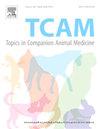猫疱疹病毒和杯状病毒:猫呼吸道疾病的发生和病理。
IF 1.3
3区 农林科学
Q2 VETERINARY SCIENCES
引用次数: 0
摘要
猫疱疹病毒(FHV)和猫杯状病毒(FCV)是猫呼吸道疾病的主要病原体。尽管在常规病理诊断中经常观察到致命的呼吸系统疾病,但很少研究病毒参与的作用。本研究旨在利用免疫组织化学方法评估FHV和FCV在死猫致命呼吸道疾病中的作用,并根据阳性猫的病理和流行病学结果确定受感染组织的特征。对60只猫进行了评估。在12只猫身上观察到FHV的免疫标记,在7只猫身上观察到FCV的免疫标记,在3只猫身上观察到两种病毒的免疫标记。这些FHV和fcv阳性猫(n=22)被纳入研究。14只猫同时感染猫免疫缺陷病毒(FIV)和猫白血病病毒(FeLV),其中FeLV阳性6只,FIV阳性4只,FeLV和FIV阳性4只。肉眼病变主要局限于呼吸道和上消化道。组织学分析显示,受影响的组织包括鼻腔、口腔、食道、喉部、气管和肺部。所有fcv阳性猫和大多数fhv阳性猫在上呼吸道/消化道出现糜烂、溃疡和纤维蛋白坏死病变,并伴有肺炎(18/22)。其余4/22只猫都感染了FHV,病变仅限于上呼吸道。fhv阳性猫表现为支气管间质性肺炎,而fhv阳性猫表现为纤维蛋白化脓性肺炎。这项研究强调,肺炎是感染FCV和FHV的猫的一个重要死亡原因,特别是那些同时感染逆转录病毒的猫。它还强调了在尸检过程中从呼吸道和上消化道收集样本的重要性,并使用免疫组织化学来确认病毒感染因子的参与-即使在成年和老年猫中也是如此。本研究结果可能有助于对猫科动物呼吸系统疾病的进一步研究。本文章由计算机程序翻译,如有差异,请以英文原文为准。
Feline herpesvirus and calicivirus: Occurrence and pathology in cats with respiratory disease
Feline herpesvirus (FHV) and feline calicivirus (FCV) are the primary causative agents of respiratory disease in cats. Although fatal respiratory disease is frequently observed in routine pathological diagnostics, the role of viral involvement is rarely investigated. This study aimed to assess the involvement of FHV and FCV in necropsied cats with fatal respiratory disease using immunohistochemistry, and to characterize the affected tissues, along pathological and epidemiological findings of the positive cats. Sixty cats were assessed. Immunolabeling for FHV was observed in 12 cats, for FCV in seven cats, and for both viruses in three cats. These FHV and FCV-positive cats (n = 22) were included in the study. Co-infection with feline immunodeficiency virus (FIV) and feline leukaemia virus (FeLV) was observed in 14 cats (six FeLV-positive, four FIV-positive, and four FeLV and FIV-positive). Gross lesions were mainly restricted to the respiratory and upper digestive tracts. Histological analysis revealed that the affected tissues included the nasal and oral cavities, esophagus, larynx, trachea, and lungs. All FCV-positive cats and most FHV-positive cats presented erosive, ulcerative, and fibrinonecrotic lesions in the upper respiratory/digestive tracts, concomitant with pneumonia (18/22). The remaining 4/22 cats, all infected with FHV, had lesions restricted to the upper respiratory tract. FHV-positive cats showed a bronchointerstitial pneumonia, whereas FCV-positive cats exhibited a fibrinosuppurative pneumonia. This study highlights pneumonia as an important cause of death in cats with FCV and FHV infection, particularly in those co-infected with retroviruses. It also emphasizes the importance of collecting samples from the respiratory and upper digestive tracts during necropsy and using immunohistochemistry to confirm the involvement of viral infectious agents—even in adult and aging cats. The findings of this study may contribute to further investigations into feline respiratory diseases.
求助全文
通过发布文献求助,成功后即可免费获取论文全文。
去求助
来源期刊

Topics in companion animal medicine
农林科学-兽医学
CiteScore
2.30
自引率
0.00%
发文量
60
审稿时长
88 days
期刊介绍:
Published quarterly, Topics in Companion Animal Medicine is a peer-reviewed veterinary scientific journal dedicated to providing practitioners with the most recent advances in companion animal medicine. The journal publishes high quality original clinical research focusing on important topics in companion animal medicine.
 求助内容:
求助内容: 应助结果提醒方式:
应助结果提醒方式:


